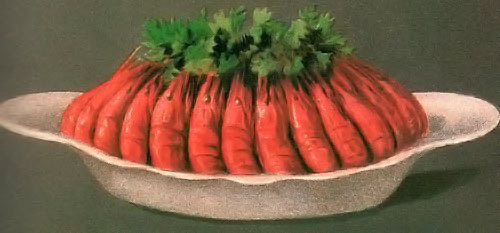A southern expression of curried shrimp and lemon rice to enhance it.
Another recipe by Eugene Walter, this from his posthumous Happy Table. Nobody could mistake the preparation for anything remotely Indian, although it is a recognizable variation of the British model. You will want a big bowl of ice and water to hand for shocking the shrimp immediately after prising them from the pot. Walter likes to prepare the curry before cooking the rice so the shrimp mixture can ‘hatch’ or settle to deepen its flavor. For four.
 For the curry:
For the curry:
- about 1 Tablespoon crab boil or pickling spice (see the Notes)
- 2 lb shrimp in their shells
- 4 Tablespoons butter
- 2 chopped but not peeled green apples
- 2 cups chopped celery
- 1 cup chopped onion
- 1 cup dry white wine-1 teaspoon celery seed
- heaped Tablespoon curry powder
- heaped teaspoon ground ginger
- heaped ¼ teaspoon mace
- 1 cup heavy cream
For the rice:
- 2 Tablespoons unsalted butter
- 1½ cups rice
- 2½ cups warm water
- cayenne
- ½ cup lemon juice
- 1 Tablespoon lemon zest
- heaped teaspoon turmeric
- cayenne
- Bring the water and spice to a rolling boil: throw the shrimp into the pot. As soon as they turn pink and cool, wrest them from the pot and into the icebath. Peel them when cool enough to handle.
- Melt the butter over medium heat and cook the apple, celery and onion just to coat them, then pour on the wine, reduce the heat to a simmer and let the mix cook until just almost tender, stirring at a judicious pace.
- Add the celery seed, curry, ginger and mace followed by the cream, then give the pot a good stir. You might add a splash more wine; in any event once the curry thickens add the peeled shrimp, then cover the pot and turn off the heat.
- Make the rice by melting the butter over medium heat and then turning the rice until uniformly glistening. If you dare, allow the rice to color to a pale gold; if you choose to do so the rice will be even better than if you do not, but you will need to stir the rice like a lunatic.
- Pour on the water and add some cayenne, the lemon juice and zest, the turmeric and some salt.
- Cook the lemon rice, stirring much of the time, until the rice absorbs the water until, as Walter writes, “you hear the first clicking sounds as the first grains stick to the bottom.
- Cover the rice with a damp tea towel while you carefully reheat the curry.
- Serve the curried shrimp with the rice.
Notes:
-Walter specifies bay, celery leaves, peppercorns and, dissonantly, dill, as the elements of his boiling spice, which he considers “your usual boiled-shrimp flavorings.” Crab boil is more convenient and better, although to be fair he was ahead of his time in his regard for celery leaf.
-As with many things, Walter’s perspective on the preparation of shrimp is both perplexing and inconsistent. He specifies different cooking times, all of them too long, in different recipes, and insists on letting the shrimp cool in their cooking liquid for ages. That way lies mushy ruin.
-Walter did not have access to canned coconut milk, but if he did he may have preferred it to the cream. We do.
